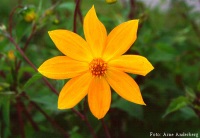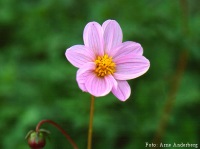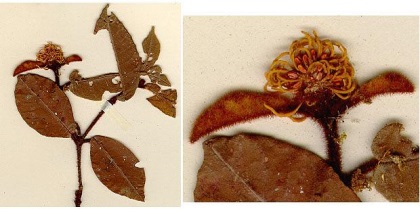Andreas Dahl
Andreas Dahl was one of Carl Linnaeus' students at the university of Uppsala. Dahl was after his exam employeed as a curator at Claes Alströmer's natural cabinett.

Andreas (Anders) Dahl was born on March 17th, 1751 in the parish of Varnhem in Västergötland, Sweden. He was the son of the preacher Christoffer Dahl and his wife Johanna Helena Enegren. He was probably christened Andreas but was called Anders.
Childhood
He had an older brother Erik (born 1758 in Varnhem), a younger brother Kristoffer (born 1758 in Saleby) and a half-brother Olof Kolmodin Dahl (born 1766 in Saleby). The family moved in 1755 from Varnhem to the parish of Saleby outside Lidköping where Christoffer Dahl became parish priest. Johanna Helena died in 1760. Two years later, Cristoffer married Helena Elisabeth Kolmodin, daughter of the poet Olof Kolmodin. After her death in 1768 Cristoffer Dahl married a third time in 1770, now with Anna Christina Svinhufvud.
Education
In 1761 Dahl began school in Skara. During school he and his friends were very intrested in natural science. Andreas Dahl, Johan Abraham and Leonard Gyllenhaal, Johan Afzelius, Daniel Naezén and Olof Knös founded on the 13th of December 1769, together with the parish priest and naturalist Clas Bjerkander, "The Swedish Topographic Society in Skara".
The members wrote reports about plant- and animallife, geography, topography, historical monuments and economic life mostly from Västergötland. During these years (around 1770) Dahl wrote several essays in different subjects, most of them are unpublished.
On the 3rd of April 1770 Andreas Dahl was enrolled at the University of Uppsala. There he was one of Carl Linnaeus' students. After his father's death in 1771 his family fell into a financial crisis and Andreas had to prematurely end his education. On the 1st of May 1776 he passed a preliminary candidate examination of medicine.
Alstömer´s natural cabinett
Thanks to recommendations from Linnaeus, Dahl was after his exam employeed as a curator at Claes Alströmer's natural cabinett and botanical garden at Kristinedal in Gamlestaden outside Gothenburg. Andreas Dahl followed Claes Alströmer when he in 1785 moved to his estate Gåsevadsholm outside Kungsbacka, after that he had fallen into a bad economical predicament.
Honorary doctor in Kiel
In 1786 Dahl was confered a honorary doctor's degree of medicin in Kiel and in 1787 he became associate professor and botanical demonstrator at the university of Turku (Åbo). To Turku he brought his herbarium which later was destroyed in the big fire in Turku in 1827. Parts of Dahl's collections are preserved and kept in Sahlberg's herbarium in the Botanical Museum at the University of Helsinki and in Giseke's herbarium in the Royal Botanical Garden Edinburgh.
Dahl died in 1789 in Turku in the age of 38.

Botany
Andreas was at an early age interested in botany. Anders Tidström, associate professor and disciple of Linnaeus met during his second journey through Västergötland in 1760 the then nine year old Andreas. Tidström tells in his travel diary about Andreas' intrest in botany and his collection of plants recived from his uncle Anders Silvius, chemist in Skara.
Journeys
The employment at Alströmer's involved several journeys in Sweden and abroad. During these journeys Dahl collected natural history specimens both for Alströmer and himself. It was during his time at Alströmer's Dahl got in touch with the material in the Linnean collection now included in the collections of the Swedish Museum of Natural History in Stockholm. The Linnaean disciple Alströmer recived several plants from Linnaeus himself who generously sent specimens to his friends.
After the decease of the son of Carl Linnaeus in 1783 Claes Alströmer recived the so called "herbarium parvum"". This herbarium consisted of duplicates sorted out from Linnaeus herbarium and other plants collected by the younger Linnaeus himself. Alströmer had helped Linnaeus son financially under his journey to England in 1781 and as a thanks Alströmer inherited the herbarium.
Dahl has, on every sheet in Alströmer's herbarium written with his legible handwriting whether the sheets came from "a Linné P." or from "a Linné f.", where "P" stands for "Pater" and "f." for "filius". In some cases Dahl himself has recived specimens.

On this sheets he wrote "Dahl a Linné P." or "Dahl a Linné f.". After the decease of Claes Alströmer in 1794 his herbarium was left to the Royal Swedish Academy of Sciences subsequently the Swedish Museum of Natural History.
The specimens Dahl and Alströmer recived from Linnaeus and his son are now kept in the Linnean herbarium in Stockholm.
in Stockholm.
Dahl's friend from school, Adam Afzelius, who in 1785 was employed at the University of Uppsala, was working on a new edition of Linnaeus's Flora Svecica. Andreas Dahl contributed with information about species and plant localities from the Swedish West Coast. He also contributed to the description of several species and to their position in the Flora according to Linnaeus sexual system.
Publications
Some of the papers Dahl wrote during his student years in Skara and Uppsala are now kept in the Olof Knös Collection in the county library of Skara. Among those are some inventories over the flora around Skara and Saleby. In the minute-book of "The Swedish Topographic Society in Skara", which is also kept in the Olof Knös Collection, there are also some papers written by Dahl.
Inspired by Linnaeus, Dahl wrote a Horologium Florae, a flower-clock over Skara. This paper was posthumous published in "Ny Journal uti Hushållningen", in May-June 1790. The article was probably published by Olof Knös who was the keeper of the minute-book. Also Johan Abraham Gyllenhaal's collections in the university library of Uppsala contain some papers written by Dahl.
On the 3rd of January 1777, an extract from an anonymous letter was published in Inrikes Tidningar. The writer had during his journey from Stockholm to Gothenburg in July 1776 visited "Himmels-Källan" in Varnhem. The quality of the spring was described in the letter and 58 species from the swamp around the spring are noted. Since Andreas Dahl often visited Varnhem and his friend Jonas Odhner it is most likely that the letter came from him.
Andreas Dahl's only publication during his time in Gothenburg was a diary over draggings in the archipelago of Bohuslän published in Trangrum-Acten (Stockholm, 1784). Dahl was one of three members in a commission who wrote a regulation of the waste from the try houses. The wastes from the manufacturing of herring oil was a major problem during the big herring fishing periods and was the cause of sea bed deaths and stinking water. This document was the first Swedish step towards a restriction of industrial waste.
During his few years in Turku Dahl published his most important work: Observationes botanicae circa systema vegetabilium divi a Linne Gottingae 1784 editum, quibus accedit justae in manes Linneanos pietatis specimen. (Kopenhagen, 1787).

Eponymy
In the 1780's, Dahl's friend from Uppsala, Carl Peter Thunberg , named a plant from the plant family Hamamelidaceae after Dahl, Dahlia crinita, but did not publish the name until 1792. The species epithet crinita comes from the Latin word for longhaired which aimed at Dahls big beard.
, named a plant from the plant family Hamamelidaceae after Dahl, Dahlia crinita, but did not publish the name until 1792. The species epithet crinita comes from the Latin word for longhaired which aimed at Dahls big beard.
The name Dahlia was though already used in 1791 by the Spaniard Cavanilles for a genus of composite plants introduced to Europe from Mexico in 1784. To the right you can see a specimen of Thunberg's plant, now called Trichocladus crinitus (Thunb.) Pers., from the collections of Swedish Museum of Natural History.
References
Corneliuson, J. 1997. Växternas namn. Vetenskapliga växtnamns etymologi. - Wahlström & Widstrand, Stockholm.
Kilander, S. 1985. Efter Linnés västgötaresa. Botanikhistoriska notiser från ett halv sekel. - Svenska Linnésällskapets årsskrift 1984-85: 127-164.
Kilander, S. 1988. Anders Dahl som botanist och topograf i Västergötland. - Västgötalitteratur 1988: 3-27.
Lindman, C. A. M. 1907. A Linnaean Herbarium in the Natural History Museum in Stockholm. 1. Monandria-Tetrandia. - Arkiv för botanik 7(3): 1-57.
Nordenstam, B. 1978. Linné, baron Bielke och den otacksamma göken - en linnéväxt berättar. - Fauna och flora 3: 97-160.
Mejier, B. & Th. Westrin, red. 1906. Nordisk familjebok, konversationslexikon och realencyklopedi, femte bandet - Stockholm.
Saelan, T. 1916. Finlands botaniska litteratur till och med år 1900 - Helsinki.
Stafleu, F. A. & R. S. Cowan 1976. Taxonomic literature, vol. 1: A-G - Utrecht.


